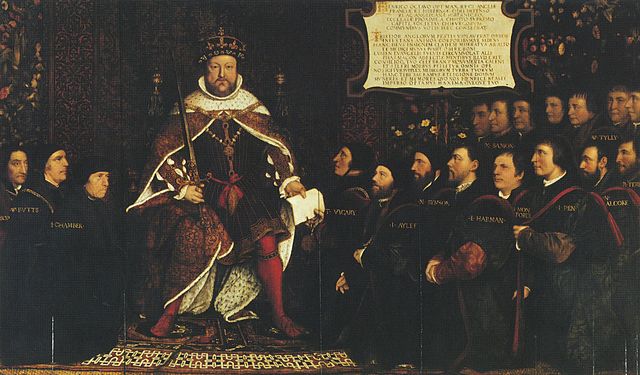
File:Henry VIII and the Barber Surgeons, by Hans Holbein the Younger, Richard Greenbury, and others.jpg

| |
This is a file from the Wikimedia Commons. Information from its description page there is shown below.
Commons is a freely licensed media file repository. You can help. |
Summary
| DescriptionHenry VIII and the Barber Surgeons, by Hans Holbein the Younger, Richard Greenbury, and others.jpg |
English: Henry VIII and the Barber Surgeons. Oil on oak, 108.3 × 312.4 cm, Royal College of Surgeons of England, London.
  This large-scale work was commissioned to commemorate the grant of a royal charter to the Company of Barbers and the Guild of Surgeons on their merger in 1540. Presumably at the request of his clients, Holbein based the design on that of the miniatures painted on Tudor charters of privileges. Henry did not sit for this last of Holbein's portraits of him. Working from an existing sketch, Holbein painted him not so much as a living person but as an icon. The members of the company, however, were painted as individuals. The figures of Sir William Butts and the doctor John Chambers are closely related to portraits of them by Holbein (left).
|
|||||||||||||||||||||||
| Date | Begun c 1543; additions and reworkings mid-16th century and 17th century | |||||||||||||||||||||||
| Source | Stephanie Buck, Hans Holbein, Cologne: Könemann, 1999, ISBN 3829025831. | |||||||||||||||||||||||
| Author |
|
|||||||||||||||||||||||
Licensing
The official position taken by the Wikimedia Foundation is that "faithful reproductions of two-dimensional public domain works of art are public domain, and that claims to the contrary represent an assault on the very concept of a public domain". For details, see Commons:When to use the PD-Art tag. |
|||||
File usage
The best way to learn
SOS Children aims to make Wikipedia suitable for young learners. SOS Children is famous for the love and shelter it brings to lone children, but we also support families in the areas around our Children's Villages, helping those who need us the most. Go to http://www.soschildrensvillages.org.uk/sponsor-a-child to sponsor a child.


